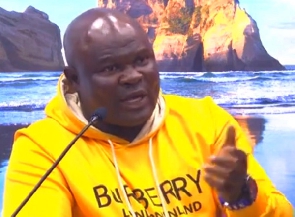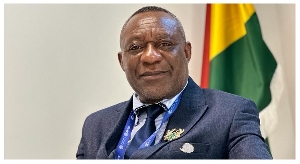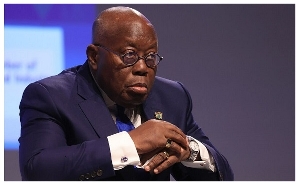- Home - News
- TWI News | TV
- Polls
- Year In Review
- News Archive
- Crime & Punishment
- Politics
- Regional
- Editorial
- Health
- Ghanaians Abroad
- Tabloid
- Africa
- Religion
- Election 2020
- Coronavirus
- News Videos | TV
- Photo Archives
- News Headlines
- Press Release
Business News of Wednesday, 27 February 2002
Source: .
Ghana Wins Debt Service Relief
IMF Press Release: Ghana to Receive $3.7 Billion in Debt Service Relief: The IMF and World Bank Support Debt Relief for Ghana Under the Enhanced HIPC Initiative
Ghana's creditors have agreed to write off 3.7 billion dollars of the country's external debt servicing on condition the government in Accra follow World Bank and International Monetary Fund (IMF) prescriptions for economic restructuring.
Ghana is the 26th country to qualify for relief under the Heavily Indebted Poor Countries (HIPC) Initiative, the Bank and IMF said Wednesday. It stands to see a 67-percent reduction in its debt servicing payments to the World Bank's International Development Association (IDA) over the next 20 years, and a 49-percent drop in its required servicing of debt owed to the IMF over the next 8 years.
IDA said it was committing 781 million dollars for its portion of the comprehensive relief package; the IMF said it would spend 112 million dollars.
Both lenders will begin providing debt relief immediately, as will most official bilateral creditors, the statement added.
Under Ghana's draft Poverty Reduction Strategy, due to be finalized during the first half of the year, funds freed up by the debt relief will be directed primarily at "increased expenditures on education, health, programs to improve services and infrastructure in the rural sector, and improved governance," the agencies said.
Some of the savings also would be used to lighten the burden of domestic public debt.
Countries under HIPC often must stick to a rigid program of economic reforms from the 'decision point', the time when the creditors agree to write off the debt, to the 'completion point', when international creditors express satisfaction with the program and actually trim the arrears.
Over the last 20 years, Ghana's debt stock has steadily risen, reaching a new high of 6.88 billion dollars in 1998. Two-thirds of the long-term debt is owed to multilateral creditors, mainly IDA. One-fourth is owed to bilateral creditors, the largest being Japan, with the remainder due to private sources, according to the Zimbabwe-based African Forum and Network on Debt and Development (AFRODAD).
The country has been implementing a program of economic restructuring with the support of the IMF and the Bank, which in the past have described Ghana as a model country because of its record of implementing structural adjustment programs stretching back to 1983.
The lenders' latest conditions include government action to strengthen the financial sector, better manage public expenditure, and pursue further privatization. Other priorities include a petroleum-pricing formula and development of plans for full cost recovery in electricity and water - meaning that all government expenditures in these sectors would have to be recovered through means such as consumer charges.
"Ghana's macroeconomic and structural adjustment record over the past decade was generally positive, although interrupted periodically by episodes of weak macroeconomic management and exogenous shocks," said the statement.
But the country's macroeconomic conditions now are not favorable for growth: deteriorating terms of trade, high inflation, and shortfalls in external assistance and privatization receipts.
The economy is mainly rural, with agriculture accounting for about 60 percent of the labor force. For its export income, Ghana relies heavily on cocoa, timber, and pineapples. More recently, gold mining has become a large source of foreign exchange.
Ghana has an annual per capita income of 390 dollars, lower than other Sub-Saharan countries, according to the IMF. It has a Human Development Index ranking of 129 out of 174 countries.
AFRODAD says that Ghana spends 7.7 percent of its gross domestic product on debt servicing but only 1.8 percent on health and 4.2 percent on education. Nearly 44 percent of the country's 19 million people suffer from lack of access to clean water and almost 80 percent still live on less than one dollar a day.
Debt campaigners, who complain of the debt burden on poor nations, say that total cancellation of both bilateral and multilateral debt is the only way out in order to free up funds for real economic and human development in Ghana and other poor African nations.
Sub-Saharan Africa's total external debt stands at about 370 billion dollars, according to AFRODAD. HIPC assistance now stands at nearly 40 billion dollars, say the Bank and IMF.
AFRODAD also says African governments owe foreign creditors an average of almost 400 dollars for every man, woman, and child on the continent; the average annual wage in most countries is less than that.
Earlier this month, several African civil society groups said they wanted to see a new court mechanism to help settle the continent's suffocating debt.
AFRODAD says that sub-Saharan Africa spends more than twice as much on debt servicing as on basic health services.
Thirty-three of the 41 countries classified as HIPCs by the IMF and Bank are in Africa.
Launched in 1996, the HIPC scheme aims to reduce the debt - particularly that part of the debt owed to multilateral agencies like the Bank and the IMF - of the world's poorest countries to less unsustainable levels, initially below 200 percent of the value of each debtor's exports.
Some of the other countries with debt relief packages under the initiative are: Benin, Burkina Faso, Cameroon, Chad, Ghana, Gambia, Guinea, Guinea-Bissau, Guyana, Honduras, Madagascar, Malawi, Mali, Mauritania, Nicaragua, Niger, Rwanda, Sao Tome & Principe, Senegal, Tanzania and Zambia.










